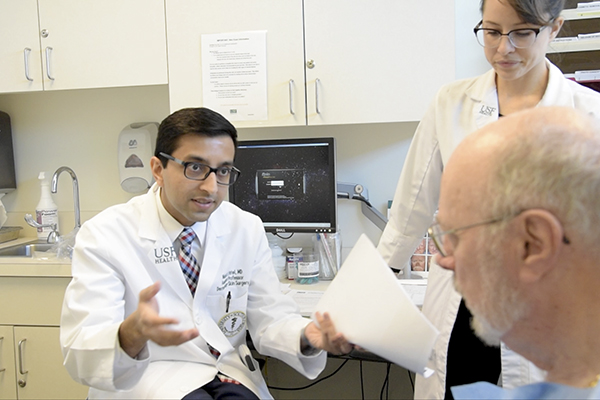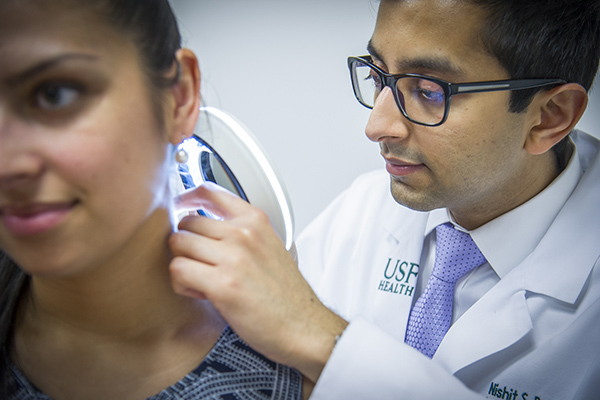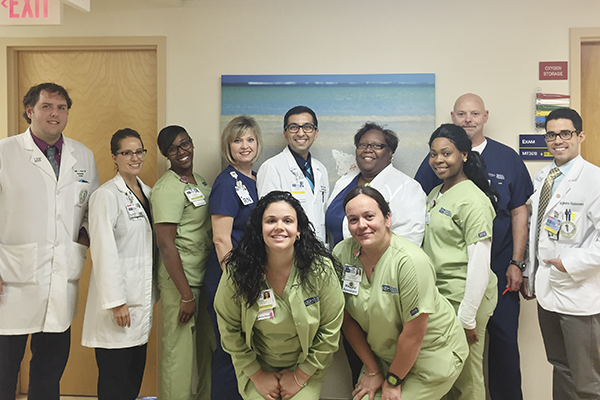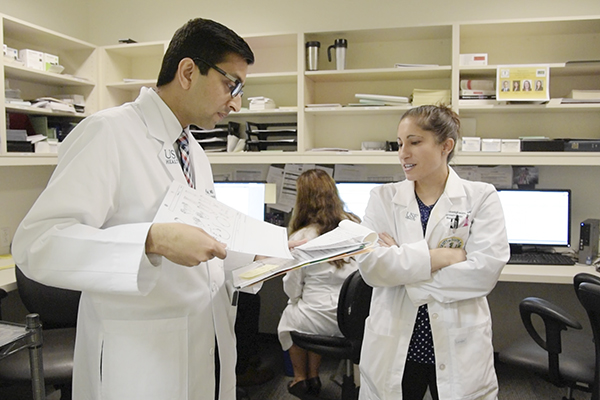This story is part of a series highlighting faculty who are shining examples of quality and compassionate patient care and patient safety. Every day, these health care providers put their patients first. In the process, they create successful models of advanced care focused on empathy, safety, technology and evidenced-based medicine, models that carry through everything they do – into their practice, their teaching, their research, their community outreach, and into the USF Physicians Group.
Reams of information helped him determine what college he would attend and which residency programs to apply for. Statistics help him know which medications are the most effective for his patients. And archived scientific literature helps him conduct his own research.
So Nishit Patel, MD, knows data is useful.
But what he has come to discover in the few years since becoming a doctor is that big data will, in the very near future, help researchers find cures – big cures, like for cancer and Alzheimer’s.
Dr. Patel is a dermatologist for the USF Physicians Group and was recently named the chief medical information officer for data analytics for USF Health. In that role, he will work with USF Health Information Systems and USFPG leadership to oversee the business intelligence platform and ensure that data reported from the system is both meaningful and credible. In addition, he will help guide the expansion of the newly developed research data warehouse.
Pulling from such vast amounts of data will help the USFPG improve patient care, from streamlining how quickly a patient can get in to see a USF health care provider to – the ultimate goal – improving health outcomes.
***
Big data is more than collections of demographics and shopping patterns and political bents. In science, big data looks at the tiniest of details in an enormous sample size. Even cellular functions, mutations, secretions, and bindings can play out across the million-fold and reveal trends that, in smaller sample sizes, might seem like outliers and oddities.
Dr. Patel had his own ah-ha moment for just how impactful data can be for improving patient care. And it pushed him to start a dermatology clinic focused on a patient population in need of that expert care.
In his training, he had learned that organ transplant patients are at a much higher risk for developing skin cancer, but there is little research on how to significantly reduce this risk and little indication that the bulk of these patients are getting intensive, personalized dermatology care.
“In looking at skin cancer and solid organ transplant patients, this is an area where there is very little research currently that can help change how we take care those patients,” he said. “Patients who’ve had organ transplants are at very high risk compared to the average population for skin cancer. In fact, they can have a 65 times higher risk for squamous cell skin cancers. Right now our treatment paradigm is that we try to detect early, we try to do what we can in terms of prevention, but at the end of the day there are lots of patients in that transplant population experiencing 5, 10, 15 skin cancers a year.”
Seeing an opportunity to fix a problem, Dr. Patel worked with Tampa General Hospital’s transplant team to design a dermatology clinic specifically for transplant patients and part of the post-surgery care.
“There was an incredible need because transplant patients were not being optimally managed for skin cancer prevention, detection, and treatment,” he said. “By creating and building this clinic from the ground up, we had a chance to capture all these patients so that, as soon as they get their organ transplant, they are automatically seeing us in the dermatology clinic. We get a chance to sit down with them and talk in very frank language: this is what your risk is for skin cancer and you’ve survived a lot to get your organ transplant so let’s make sure that you don’t have a bad outcome because we didn’t catch or treat a skin cancer early enough.”
The result is that transplant patients, who already beat death by getting a transplant and are beating organ rejection, are now beating skin cancer. Since opening in October, he has seen 230 patients. At the 100th patient mark, Dr. Patel said, they had discovered more than 50 squamous cell skin cancers, basal skin cancers, atypical moles and melanomas on those patients and destroyed countless pre-cancers.
Aside from these good statistics, it was a thank you from a patient that gave him a true feeling of success.
“Within the first few months of starting the clinic, a patient returned for a follow-up from a biopsy for a squamous cell skin cancer in his scalp,” he said. “As we were walking out of the room, he paused and said ‘Thank you so much for starting this clinic. If it wasn’t for this program I would have never gone to the dermatologist.’ It’s very likely that his skin cancer in the scalp would have continued to grow and potentially spread. But because of this program, we found that cancer, we’re treating that cancer, and his life expectancy won’t be adversely affected by it. That is more rewarding than anything else. That is the whole point.”
Data presented the trend that drove the vision for the clinic that improved patient outcomes.
***
In addition to being an assistant professor of medicine in the Department of Dermatology and Cutaneous Surgery, he is also associate program director for USF’s Dermatology residency program. So, he’s a teacher to new physicians, and he’s helping them learn from the start how to input data and use data to practice better medicine.
“My mentors tell me they used to practice medicine in a way that was eminence-based, meaning that when the person they trained under said ‘that’s how it’s done,’ well, that’s how it’s done,” he said.
“Well, over the past 10 years, especially over the past few years, there has been a shift from eminence-based to evidence-based. That is such a powerful change in terms of how we care for patients and to do that, of course, you have to have good evidence, which means you have to have good data. Look at where we have gone with transitioning from paper records to electronic medical records to really aggregating pools of different sources of data. We have this amazing opportunity in terms of the next few years to look at data in a completely different way than we have in the past.”
At USF Health, that means electronic health records, but also a soon to be released research data warehouse built by USF Health Information Systems.
“Here at USF Health, we are developing a really great research database as a resource for clinicians and researchers, whether they’re bench researchers, translational, or in clinical medicine, to very easily access a pool of data they’ve never had the opportunity to pull together before,” Dr. Patel said. “Providing tools like Epic or our data warehousing efforts means we are building the giant infrastructure and the toolkit for all of our researchers to use and to develop that next great drug, to treat severe disease, and design that next great prevention strategy. I’m really optimistic about where we’re going and I think we can continue to transform how we practice medicine and to do it in a smarter way than just how we’ve been trained.”
***
It seems to be all about data, but Dr. Patel is quick to note the constant need to stay focused on the patient. The data will help, but not at the cost of direct, focused care.
“In looking at the bigger picture of a patient’s entire medical record, or of every patient in an entire health care system like USF and the inpatient data with the integrated medical records data we have with Tampa General, you’re going to find trends that you would otherwise never even realize were there,” he said.
“That’s when the power of data improves patient care. The beauty is, by creating that infrastructure for experts to look at a huge aggregate pool of data from their lens and offer analyses together, we can really change how we’re doing things in the clinics and how we can take the best care of that patient in front of us right now.”
Story by Sarah Worth, photos and video by Sandra C. Roa, USF Health Communications.





